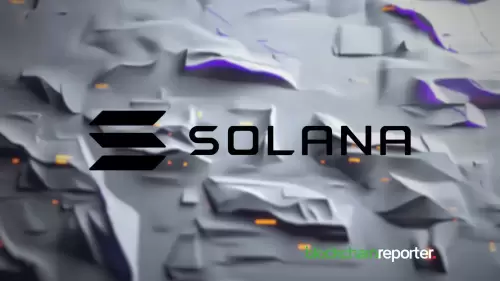 |
|
 |
|
 |
|
 |
|
 |
|
 |
|
 |
|
 |
|
 |
|
 |
|
 |
|
 |
|
 |
|
 |
|
 |
|
加密货币新闻
Crypto lending has undergone a seismic transformation since the collapses of 2022 and 2023
2025/05/07 20:01

The crypto lending landscape has undergone a significant transformation since the collapses of 2022 and 2023. In its April 2025 report, Galaxy Research provides a comprehensive analysis of how the ecosystem has evolved.
From the fall of major centralized lenders like Celsius, BlockFi, and Genesis to the resilience of decentralized protocols like Aave, Compound, and MakerDAO, the report covers the key shifts that have shaped the lending market.
Insiders Token
Annuities: A Risky Bet
Galaxy Research focuses on the collapse of major U.S. centralized lenders in 2022–2023, which was triggered by the credit crisis.
Institutions like Celsius, BlockFi, and Genesis went bankrupt due to a combination of under-collateralized loans, interconnected counterparty risk, and inadequate transparency. These lenders offered high yields to users, funded largely through risky lending strategies.
As liquidity dried up and crypto prices plummeted, a chain reaction of insolvencies began. Together, these lenders are estimated to have lost over $10 billion in customer assets.
The report details how the collapses led to heightened regulatory scrutiny, a shift in lending practices towards stricter risk management and collateral discipline, and increased diligence on borrowers.
It also notes the implications for Tether (USDT), the largest stablecoin, which has become a dominant force in crypto lending, especially in emerging markets due to U.S. banking restrictions.
DeFi lending protocols, in contrast to their centralized counterparts, emerged relatively unscathed from the crisis. Their automated and overcollateralized structures allowed them to liquidate bad loans without becoming insolvent.
However, despite the rapid growth of DeFi lending in 2024, rendering it larger than U.S. bank lending, the report highlights ongoing challenges for the ecosystem.
These include the threat of smart contract exploits, governance attacks, and oracle risks. Additionally, liquidity remains fragmented across protocols, and capital efficiency is still low compared to traditional finance.
Despite these issues, institutional interest in DeFi is steadily increasing, especially with the emergence of permissioned DeFi, which combines on-chain automation with KYC controls, rendering it more palatable to institutions.
Prime brokers and institutional lenders are returning to the market after a period of withdrawal following the 2022 collapses. Now, they are offering products with a focus on secure custody, real-time collateral monitoring, and legal enforceability in line with institutional requirements.
Firms like Coinbase Prime, FalconX, and Anchorage are developing lending products that integrate regulatory compliance and transparency. These hybrid models combine the programmability and efficiency of DeFi with the trust architecture of TradFi, which could define the next phase of crypto lending.
Stablecoins now form the core of most lending activity, providing price stability and minimizing liquidation risks. While USDC remains prevalent in U.S. regulated markets, Tether continues to hold greater global market share.
Their role as settlement assets and lending currencies is expected to expand further, especially with the growing interest in real-world asset (RWA) tokenization.
Protocols like Maple, Goldfinch, and Centrifuge are integrating off-chain assets—including invoices, real estate, and treasuries—into lending pools. This has the potential to expand credit markets but poses challenges in terms of legal enforceability and counterparty risks.
The U.S. has taken steps with enforcement actions but lacks a unified regulatory framework for crypto lending, in contrast to the EU’s MiCA regulation and Singapore’s comprehensive approach.
Moreover, there is increasing pressure for stablecoin regulation, particularly on issuers like Tether due to the vast scale of their activities and close ties with institutional counterparties.
Galaxy predicts that regulatory clarity—especially on disclosures, capital reserves, and consumer protection—will be crucial for the sustainable growth of the crypto lending market.
After a tumultuous period, the crypto lending market in 2025 is smaller, more cautious, and fundamentally healthier. The new landscape features improved underwriting, stronger transparency, and broader institutional interest.
Stablecoins—particularly Tether—and real-world asset integration are shaping new use cases, while scars from past failures continue to serve as a reminder of the importance of responsible lending practices.
The industry’s next phase will likely be driven by hybrid models that combine the programmability of decentralized protocols with the trust architecture of traditional financial institutions. Crypto lending isn’t over—it’s evolving.input: In the wake of the major crypto lending collapses that shook the industry in 2022 and 2023, the lending ecosystem has undergone a substantial transformation.
As institutions adjust to a new era of crypto lending, Galaxy Research takes a comprehensive look at the latest developments in its April 2025 report.
From the downfall of U.S. centralized lenders and the resilience of decentralized protocols to the changing regulatory landscape and the growing importance of Tether (USDT) in emerging markets, the report covers key trends
免责声明:info@kdj.com
所提供的信息并非交易建议。根据本文提供的信息进行的任何投资,kdj.com不承担任何责任。加密货币具有高波动性,强烈建议您深入研究后,谨慎投资!
如您认为本网站上使用的内容侵犯了您的版权,请立即联系我们(info@kdj.com),我们将及时删除。
-

-

-

-

-

-

- UNISWAP价格预测:看涨逆转在地平线上?
- 2025-08-05 07:10:59
- UNISWAP(UNI)是否准备好看好逆转?最近的市场分析表明潜在的上升性,但是哪些因素驱动了这种乐观的前景?
-

- 比特币,以太坊,Altcoin Rally:这是最大的吗?
- 2025-08-05 07:01:56
- 加密货币市场正在加热,以太坊领导了这一指控。这是主要的Altcoin集会的开始吗?让我们研究最新的趋势和见解。
-

-

- 比特币持有人准备在看跌信号的市场出口
- 2025-08-05 07:00:39
- 长期比特币持有者显示出市场退出的迹象,作为关键指标闪光灯信号,表明尽管价格提高,但仍有可能进行更正。





























































